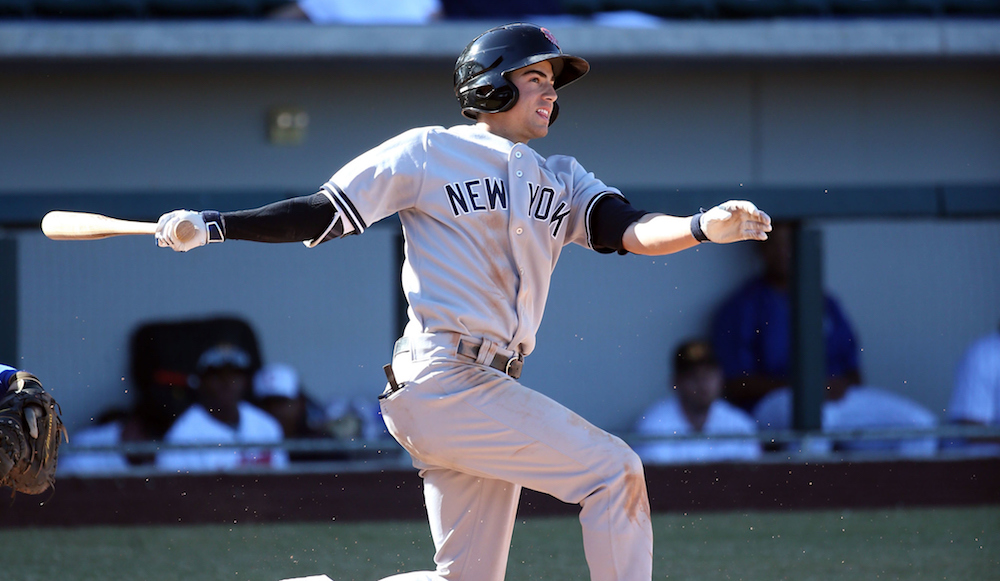Feature Photo: Tyler Wade, INF/OF, Yankees
This week, I take a look at three Triple-A prospects this week, including Dodgers outfielder Alex Verdugo, who, while improving his offensive production after a bump to Triple-A Oklahoma City this year, may find himself shut out of a promotion to the big league club because of the emergence of outfielder Cody Bellinger this season. Second baseman Willie Calhoun is still a man without a home on defense long term, which is putting a lot of pressure on developing his hit tool to have him reach his high-risk ceiling of an everyday big leaguer. Meanwhile, out in Scranton/Wilkes-Barre, the utility and athleticism of Tyler Wade is being fully tested by the Yankees in the same fashion that the Cubs have used Ben Zobrist at the big league level, with the 2013 fourth-rounder playing six positions so far this year, while almost equaling his total 2016 production at the plate and on the bases in roughly half of the games played to-date.
2080 Prospect Spotlights
 Alex Verdugo, OF, Dodgers (Triple-A Oklahoma City, Pacific Coast League)
Alex Verdugo, OF, Dodgers (Triple-A Oklahoma City, Pacific Coast League)
6’0”/205 B/T: L/L Age (as of April 1st, 2017): 20y 11m
Already one of the Dodgers’ top prospects in 2016 after being nabbed int he second round of the 2014 draft, Verdugo was one of the youngest players in the Arizona Fall League where he struggled for the first time in relatively short professional career. Verdugo had logged a full season at Double-A Tulsa, and he held his own with 36 extra-base hits, however was overmatched by the more advanced arms he faced in Arizona. Towards the end of the Fall League he started finding some more hard contact and carried that momentum over, first into the WBC for Team Mexico, and then again into the first half of the 2017 season in the PCL.
It’s been a busy 12 months for the now 21-year-old, but his struggles in the 2016 AFL have led to significant adjustments in his approach at the plate, resulting in a willingness to not only use the left side of the field more, but to do damage that way as well. Swing and miss has never been a big issue for Verdugo, but he has taken his comfort at the plate to the next level so far this season, with more walks than strikeouts (29:25 BB/SO rate). He is also sporting a lofty .364 BABIP, which to some may seem unsustainable, but when you couple it with the BB:SO rate it tells me that he is being selective, and then driving his pitch when he gets it. This is Verdugo’s first taste of Triple-A ball, so taking a step forward while climbing a level bodes well for his ability to handle a jump to the big leagues when the time comes. He is a very heady player and isn’t at all afraid, bringing a very aggressive and hard-nosed style of play that big league clubs crave down the stretch.
Defensively, Verdugo is a natural centerfielder, and he should be able to stick at the position, something that adds significantly to his value in the big leagues. He has a good first step, his routes are efficient, and he has a 55-grade arm – but he lacks that plus run you look for in a center fielder, checking in with an average run tool at best. The athleticism definitely plays up his defense, but he isn’t the same plus-defensive profile we’ve seen from the likes of current Dodgers center fielder Joc Pederson.
So while Verdugo is indeed in a very good place, he will have to show that he can continue to do extra-base hit damage as pitchers adjust to him going forward. He has six extra-base hits in his last eight games for Oklahoma City, but the .115 ISO he has on the season is only average for the offense-heavy Pacific Coast League. Verdugo is a plus athlete, and he should continue to get stronger as his body matures, however he doesn’t have a ton of physical projection like that of fellow Dodger first baseman/outfielder Cody Bellinger. Verdugo’s thicker frame likely still has some firming up to do, but at 205 pounds, there isn’t room for him to add a bunch of weight.
Ultimately, this is a kid who has several above-average tools with an approach and makeup that will allow him to get the most out of his ability. The Dodgers are in no hurry with Verdugo and given the immediate impact Bellinger has had on the club, Verdugo is likely a potential trade piece as the deadline approaches. That said, this kid will impact both sides of the ball as a regular for somebody at the big league level in the not-too-distant future. Here is some video of Verdugo from the 2016 AFL season, courtesy of Alec Dopp. – Dave DeFreitas
 Willie Calhoun, 2B, Dodgers (Triple-A Oklahoma City, Pacific Coast League)
Willie Calhoun, 2B, Dodgers (Triple-A Oklahoma City, Pacific Coast League)
Ht/Wt: 5’8”/187 B/T: L/R Age (as of April 1st 2017): 22y 5m
After a breakout 2016 campaign that saw Calhoun hammer Double-A pitching to the tune of 27 home runs and a .218 ISO mark, the young second-sacker has taken a step forward in Triple-A this year and is showing that his power is very real. While short in stature, Calhoun has a thick, strong frame and extremely quick hands that help him to create excellent barrel exit and carry on his fly balls. He does tend to work underneath the ball, however and his extreme pull approach is something that will limit his upside going forward. Of his 14 long balls in 2017, all but one have been to right field, and his tendency to try and hook balls on the outer half has resulted in turning over weak ground balls to the right side as well as pop-outs to the left side. While he does have the ability to shoot the ball the other way, he’ll need to prove he can do that more consistently, or risk being exposed by the better command that he’ll see in the big leagues, as well as the extreme shifts hitters with his profile will be defensed.
That all said, Calhoun is more than a three-true-outcome type of player, as he has always made a lot of contact (career 11.5% K rate) and has shown some ability to get on base at the upper levels of the minors (.319 OBP in 2016 at Double-A and .343 OBP so far this year in 277 PA’s). Calhoun has also done a nice job versus lefties in 2017, hitting .298 with an .918 OPS over 57 at-bats – a significant improvement from the .219 average and .575 OPS he posted versus southpaws a year ago. So while the 22-year-old isn’t without his holes, he has shown improvement in key areas while stepping up to Triple-A.
He is still without a position though, as he is a below-average defender at second base with limited arm strength and a below-average run tool. He has done better in 2017 to make the routine plays this year with only four errors in 65 games after 21 in 2016 – however the range is still a limiting factor because of the slow first-step-quickness, and that will make it hard to keep him in the infield in the big leagues. He has started to see some time in left field, but obviously the value declines a bit with the offensive profile becoming more pedestrian as a corner outfielder.
Wherever he ends up defensively, the power bat is going to drive the profile – he has a chance to work his way into an everyday role if he can move away from the pull-centric approach that will otherwise leave big holes to pitch to. That, combined with the lack of defensive value, ultimately make it a high risk profile, with the most likely landing spot being in a platoon role at the major league level, in a role comparable to that of Matt Stairs (OF/1B, 1992-2011, multiple teams). – Dave DeFreitas
 Tyler Wade, SS, Yankees (Triple-A Scranton/Wilkes-Barre, International League)
Tyler Wade, SS, Yankees (Triple-A Scranton/Wilkes-Barre, International League)
Ht/Wt: 6’1”/185 B/T: L/R Age (as of April 1st, 2017): 22y 5m
While the Bronx will need to wait a while before highly touted, uber-prospect Gleyber Torres (SS, Yankees) makes his debut, the bombers have another potential impact prospect in the making who could be the Swiss-army knife they need in the second half. Drafted as a shortstop out of high school, Wade’s profile has always been one that boasts great athleticism that pairs well with a solid glove up the middle, but it’s also a profile that falls short on impact with the bat, and has limited projection with the body. After a middling performance in the Arizona Fall League last year, Wade apparently found the gym this past offseason, and he’s already matched his 2016 power numbers in roughly half the 2017 at-bats, while also upping his running game at a similar pace, with 23 stolen bases in 27 attempts.
Wade’s compact stroke and quick-twitch athleticism are conducive to high contact rates (17.4% K rate in 2016; 16.7% in 2017), however until recently the damage hasn’t been there, which severely limited his upside and put a tremendous amount of pressure on the hit tool to carry the profile. After posting a miniscule .091 ISO in 2016 over 505 at-bats, Wade already has .137 ISO through 270 at-bats, with 24 extra-base hits and five home runs. His over-the-fence pop is primarily to the pull side, however the fact that he is now stinging the ball makes him a threat to the gaps and on the bases, and both tools bring additional depth to his game that make him a factor at the plate. In addition, Wade is now hanging in versus left-handed pitching with a solid .789 OPS over 83 at-bats, a positive trend that began in 2016.
From a defensive standpoint, the Yanks have already begun moving him around the field – a lot. He will make the routine plays, but is just average at his natural shortstop position, as his 60-grade run tool and quick actions haven’t translated to great range. However, he has solid instincts with a good game clock, and he does enough to still be a consideration there. His 55-grade arm make him a factor in the outfield as well; in fact in the AFL in 2016 he spent a great deal of time in center field, something that has continued so far this season, as well as booking time on both corner-outfield spots (5 games in the outfield to-date), and second (12) and third base (10). Like 2080’s resident scout Ted Lekas mentioned last month, Wade’s progression is looking more and more like that of Ben Zobrist (2B/OF, Cubs). So while the Torres party has been postponed until mid-2018, an under-the-radar Tyler Wade could soon step into the limelight of the Bronx and play an important role for the A.L. East contenders. – Dave DeFreitas


